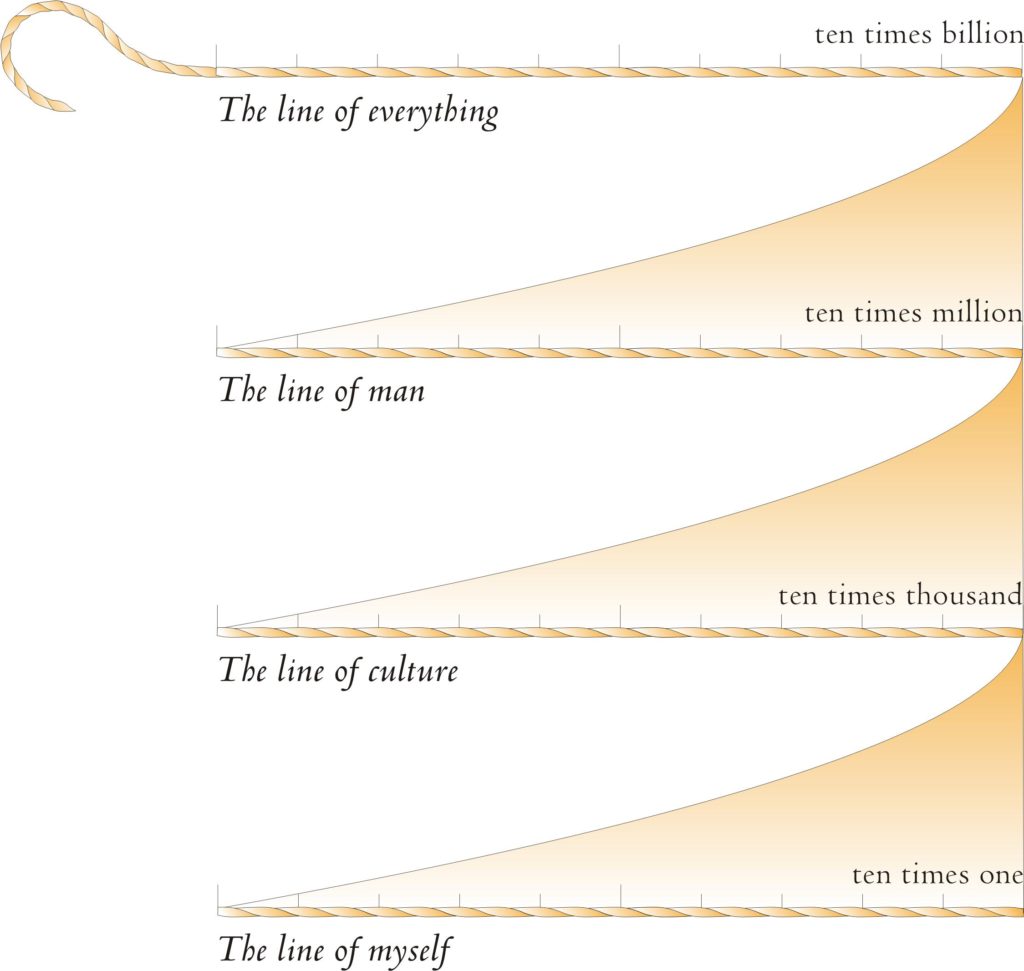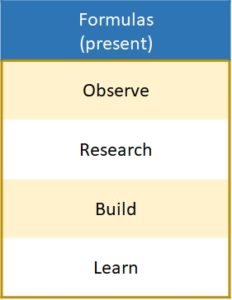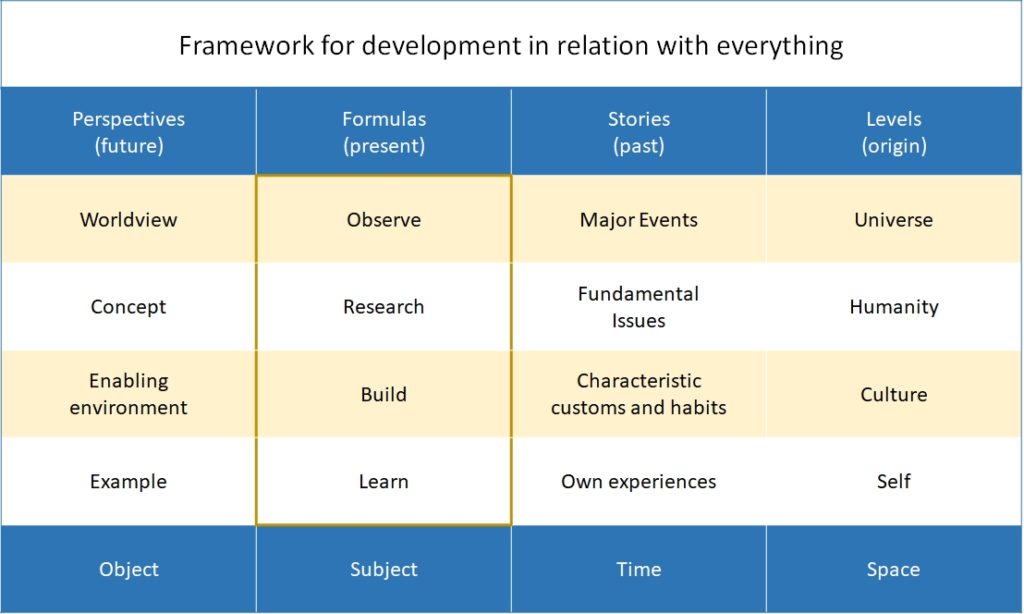(See publications)
Jos Werkhoven and I came into contact with Big History in 1997 through Fred Spier. We saw a parallel between Maria Montessori’s cosmic education and Big History. Together with a group of Montessori teachers, we set up the platform Big History primary education and in 2014 we started research into Maria Montessori as an example of Big History (Origin 2016). We presented this in 2016 at the Big History congress.
Important questions that concerns me are how life and the world are organized, how people can act in it and what we pass on to our children. I see it as a great responsibility for human beings to take care of development in relation to everything.
Framework
Inspired by the lines of life, designed by Jos Werkhoven, I have developed a framework to survey the totality of space and time. This framework shows the relationship between four levels of origin, namely universe, humanity, culture and individual self in past, present and future. This results in a framework with 16 starting points that are interrelated and all contribute to development. To quote Bateson, the 16 points of departure form a connecting pattern that shows itself as a dance of interacting parts.
We can use the framework to oversee a whole, to investigate a particular issue, to create a new practice or to learn organize in coherence. We use the stories of the past, the formulas of the present and the perspectives of the future to ensure development. With the framework we make accessible the apparently complex relationship between subject, object, time and space.
Program
We can use the framework to design programs, such as educational programs, neighborhood programs or programs on current themes. As a program leader/initiator, we choose a specific starting point from which we invite and build the program. The framework itself is an empty shell, filling itself from the point of departure we choose. It doesn’t matter where we start. Every starting point is an entrance, as long as we make connections with everything that is there. With the help of the framework, we can always oversee what still needs attention.
Four levels of origin
Jos Werkhoven describes the lines of life as a mathematical surprise, showing that each line is about one thousandth of the previous line and arises from the last fraction of this previous line. The line of everything is about 13.8 billion years. The lineage of man is about 10 million years. The line of culture is about 10,000 years and the line of myself in primary school is about 10 years. If we place ourselves on these four lines, we come to the realization that human beings in general and we in particular make up only a very small part of the total time.

Lines of life, Jos Werkhoven 1997
The level of the Universe
At the level of the universe, time is marked by major events from the Big Bang till now. A few of these major events are the formation of stars, atoms and molecules, earth and solar systems and the origin of life and humanity.

David Christian, founder of Big History calls these major events thresholds and suggests that the formula by which we observe development is the same for all thresholds: ingredients + goldilocks conditions = new complexity. Complexity grows with each subsequent threshold. Each threshold is like a jump. Perspective is the big picture as a world view.
The level of the Humanity
At the level of humanity, time is marked by fundamental issues. After fire control, the ongoing search for food is an important issue for human as a hunter-gatherer. The rise of agriculture begins with the cultivation of the land and the taming of animals. Problems such as overpopulation and climate change have likely fueled the transition to agriculture. Through agriculture there is more and more the exemption and specialization of people and with the rise of cities and states the trade comes. In the modern world, the issues are more complex. Technological developments in particular are unstoppable. We become more aware of our impact without being able to foresee the consequences. This raises the question of responsibility for this human influence. An issue that is so complex that we increasingly need a collective consciousness and a shared concept. What do we pass on to the next generation?

We become more aware of our impact without being able to foresee the consequences. This raises the question of responsibility for this human influence. An issue that is so complex that we increasingly need a collective consciousness and a shared concept. What do we pass on to the next generation?
The level of the Culture
At the level of culture, time is marked by characteristic habits and customs. In the time of the great empires, the expansion and exchange of agrarian societies, the pattern is mainly made by all rulers, the monarchs. When the great empires fell apart, the monarchs lost their power and smaller states arose. Economic and commercial influences are increasing and the pattern is more and more shaped by markets and trade. Technological development makes it easier for people to connect with each other and form more global networks. Developments are accelerating, but the issues are becoming more complex and require more power. Fred Spier (2010), one of the big historians from the beginning, describes that people can determine their own ecological and social Goldilocks conditions to a certain extent by using of matter and energy.

However, the question is what will happen in the near future, both to humanity and the Earth? This uncertainty about the future of humanity and the earth increasingly demands a global level to address these fundamental problems of humanity. A global community to face the future.
The level of the Self
At the level of the self, time is marked by development from birth to the present. We can also speak of an increasing complexity in the development of our role. Maria Montessori describes the child under 6 years as a discoverer, the child of 6-9 as an explorer and the child of 9-12 years as a ‘scientist’.

Maria Montessori describes the development of this perspective as: help me do it myself. A formula we can apply not only in education, but in our whole lives. The challenge of a lifelong learning and being an example.
Big History
The formula known to Big Historians ingredients+goldilocks conditions=new complexity that applies to all major events in the past shows us that the future is becoming more and more complex. Because our awareness is growing, we can also handle more, but the challenges are great. Humans distinguish themselves in development because we are able to specialize and share our knowledge with each other, our collective learning. As far as we know, only humans are able to develop a collective memory from which we can draw.
How do we pass this on to our children, the students, the future?
As a program leader, we can take others along in development by starting in the present. Working together from the present, everyone can choose their own starting point. The formulas in the framework form a natural cycle of observing, researching, building and learning. A cycle that will gain in strength if we relate it to the totality of space and time with the help of the framework and from there base our perspectives on the future.

Current issues, such as climate change, are slowly making us realize that the world is bigger than ourselves, our culture and humanity and ask that we contribute to development in relation to everything. What matters is that we take the signals such as the climate change seriously, have an eye for the bigger picture of which we are part, not only draw from it, but also contribute to it and take responsibility for learning together? Taking care of development requires that we know our limits, but not be the limits ourselves. That we learn to live in relation to everything, recognize that the issues are bigger than ourselves, realize that people can handle more future together than alone and that we can be an example ourselves.
An example from my current practice
In 2017 I took the initiative for an energy cooperative that works by, for and with residents of the six villages in our municipality. We are building an environment where it becomes common for residents to invest in a sustainable society and we are a platform of local expertise, voluntary and paid. We develop a vision on climate change, investigate the issues and make them concrete, build a local environment in which it becomes habitual to become more sustainable and help residents to set an example themselves and as a village.
Taking care of development
The development we go through depends on the starting point we choose and the relationships we establish. We can conclude that development in relation to everything that exists does not happen by itself. The development we go through depends on the starting point we choose, the stories we exchange, the way we bear responsibility and our perspective on the future. That needs care. Everything matters. I hope the framework inspires initiators and program leaders to care for development and make school in relation to all that is.
Making school
Help the child/student/citizen:
- see the origin and development of each of the four levels: universe, humanity, culture and individual
- storytelling on four levels
- see the challenges of the future from the perspective of the universe, humanity, culture and the individual
- realize that there can also be a future of the universe without people
- realize that everything comes together and integrates in the present
- working with the cycle: observing, researching, building and learning
- observe, explore, build and learn patterns
- use the framework for development
- framing development
- see the connecting pattern as a dance of interacting parts
- take initiatives in relation to all that is
- pick a departure point you care about
- become aware of one’s own starting point
- see one’s own point of departure in itself, sequentially, in interaction and as a whole;
- taking care of development
- do it yourself


